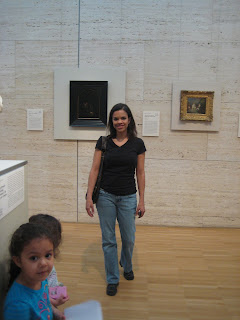

Museum Visit
I visited the Kimball Art Museum and chose Gerrit Dou's A Dentist by Candlelight (A Quack Doctor Examining an Old Man) ca. 1660-65.
Art Elements
Line -The frame of the painting is arched at the top. In the painting the archway and the curtains create vertical straight lines and horizontal curved lines.
Shape - There are many circular shapes in the painting. Including the lantern, the fixture hanging from the ceiling, the tray on the table, the basket on the table and the bun in the wife's hair. All of the inorganic circular shapes are in the foreground of the painting.
Space - The painting is two-dimensional and the space is flat. Gerrit Dou creates depth by placing a table with objects on it in the foreground. The table is placed in front of the people in the painting. Dou also creates space by having the background completely black, giving the illusion of a deep room with a vast background. In other words, Dou uses layering of figures and objects.
Light - the source of light in this painting is depicted by the candle being held by the dentist and also by the lantern on the table in the foreground. It is a dark painting with artificial light source. The shadows created by the light are true to life. The shadows are depicted by color; there is a varying degree of brightness in the figures and objects relevant to the light sources.
Color - The dominant color in this painting is black. Other dominant colors are shades of gray and yellow. Dou chose to do this to create a certain mood and effect. The mood is dark. The dentist appears to be incompetent and the man and his wife appear fearful and uncertain. The effect of the dark colors and artificial candlelight add to the sense of uncertainty. Dou utilizes warm colors in the glowing of the candlelight and lantern. He does not use atmospheric perspective.
Texture- the actual texture on the surface is rough but there is an implied smooth texture and no patterns are created through the use of texture.
Art Principles
Balance - Balance in this painting is produced by the sharp contrast between light and dark (chiaroscuro). The painting is asymmetrical. Opposites are utilized by the contrast of light and shadow.
Emphasis - My eye is drawn to two parts of the image. So I assume there are two focal points. The first focal point in the image is the candle being held by the dentist, which illuminates the close faces of the dentist and the man being examined by the dentist. The candle also illuminates the concerned lady (presumably the man's wife). The lady is also illuminated by the lantern. The lantern and lady serve as the other focal point. My eye is drawn to the wife holding the hands of the dental patient.
Rhythm - The rhythm created by repetition in this painting is depicted by the repetition of busy hands. The three characters in this painting all have their hands occupied. The dentist is holding the candle in one hand and holding his patients head steady with his other hand. The patient is holding his hat in one hand and holding his wife's hand with his other hand. The wife is holding her husband's hand with one hand and has her other hand across her chest signifying her concern for her husband. The repetition of limbs is also seen in the crocodile or alligator that is hanging from the ceiling. As the creature hands there, its limbs dangle above the figures of the three people. The rhythm is subtle but creates an intensity showing the situation, which is a man obviously in need of dental work but being in the hands of someone incompetent.
Another repeated element in the painting is loose fabric. Dou painted the attire of the characters to include garments with many layers and very loosely fitting. The drapes are also bunched with a lot of loose fabric. And there is a bunched up garment, maybe a towel, sitting on the table.
Media and Technique
The painting is a two-dimensional piece of art. It is an oil on oak panel painting. Meaning, the medium is oil paint on an oak wood panel. Since oil paint dries by oxidation, not evaporation, it remains wet for days, even weeks. This enables the artist to change the color, texture or form as he or she goes along. This also means that the colors are typically applied in thin glazes. Wood panels were used as a medium for painting before canvas become the popular choice. The panels provided solid support that allowed for great precision. Oil on wood required a painstaking multi-layered technique where the painting, or a particular part of it, had to be left for a couple of days for one layer to dry before the next was applied. Preservation of panel paintings presented challenges. The wood panels often warp and crack with age especially if kept with too little humidity.
No hay comentarios:
Publicar un comentario